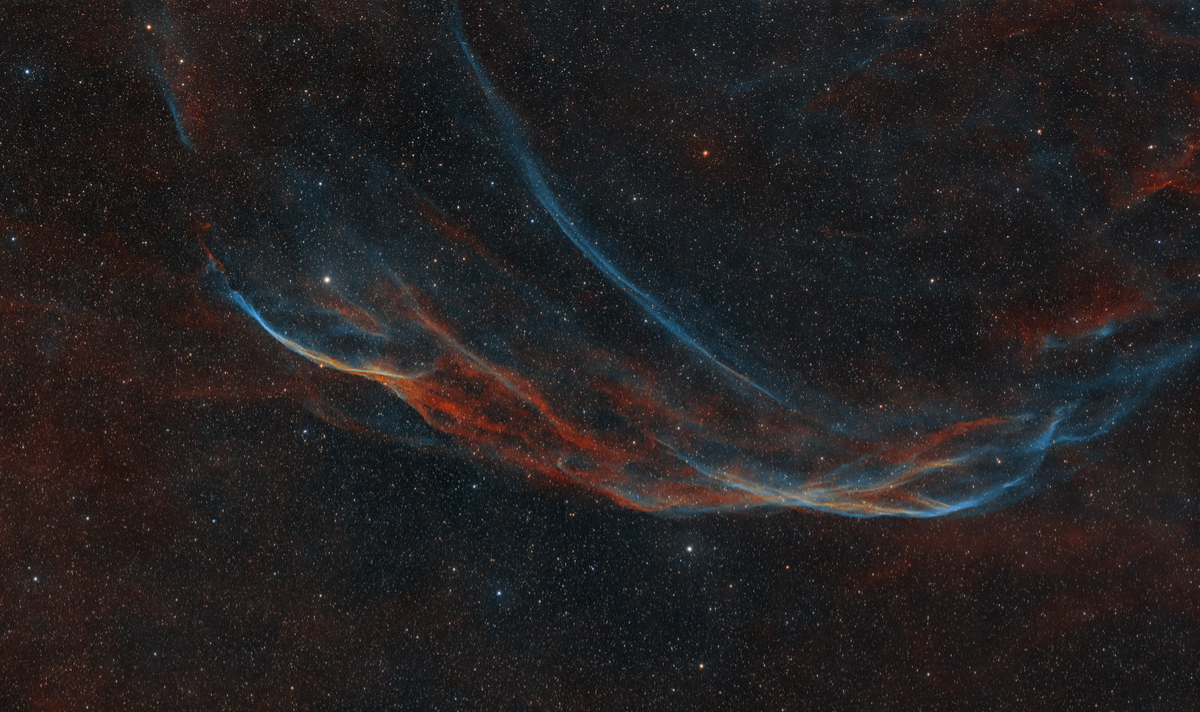
[back]
Sh2-91 (part of G65.3+5.7) in Cygnus
Higher resolved image /
höher aufgelöstes Bild (7860 x 4660 Pixel)
Anotated
version (7860 x4660 Pixel)

|
(c) 2025 All astro photo images are copyrighted. They may not be used or reproduced without explicit written permission from the authors. |
|
5' |
|
About this Image / Über dieses Bild
| Camera: | Moravian C3-PRO-61000 Mono CMOS |
| Image Type, Orientation: | SII/Ha/OIII near real color image, North is at 12:00 |
| Exposure time: | SII: 24 x 900s, Ha: 23 x 900s, OIII: 17 x 900s (16:00h total) |
| Exposure date: | October 15th...26th, 2024 |
| Location: | Capella Observatory South at Kiripotib Astro Farm, Namibia |
| Filter: | Astronomik 6nm SII, Ha, OIII filters and Astronomik Deep-Sky Filters on Moravian EFW-3L-9-II External Filter Wheel |
| Instrument: | "Callisto", a Takahashi FSQ 106N, 530mm focal length, 106mm aperture, f/5 on modified Losmandy G11 (high res encoders with OnStepX) |
| Photographer: | Rainer Raupach, Josef Pöpsel, Frank Sackenheim |
| Remarks: |
Sh2-91 is part of the supernova remnant G65.3+5.7 in the
constellation of Cygnus, located near the star Albireo. The entire SNR is an
immense structure with an approximate diameter of 5°. The image, spanning
about 3° from east to west, captures only the southeastern edge of the shock
front. This structure appears in Steward Sharpless’ catalog because its
filaments also constitute an H II region. The brightest region in the image
is sometimes cataloged as LBN 147. In addition to the main structure, the image field contains some planetary nebulae, such as PN G+64.7+0.5.0 and Kn 15 (see the annotated version of the image). The surrounding diffuse H-alpha emissions are interrupted by several dark nebulae from Lynds’ Catalogue of Dark Nebulae. The image represents narrowband channels for S II, H-alpha, and O III, which have been mapped into a color composite using the Foraxx palette. Additionally, colors of the stars have been derived using a custom-developed mapping technique that yields hues closer to those of a calibrated RGB image than those typically seen in narrowband color composites. This method utilizes intensity ratios from the narrowband data to derive an equivalent surface temperature, ensuring that the relative intensities at these wavelengths follow Planck’s radiation law. Assuming that stars behave as blackbody radiators, the derived surface temperature allows for the synthesis of an RGB distribution that closely resembles a true-color RGB image. Parts of Sh2-91 have been imaged before with Ganymed, see here and here. |
|
|
|
| Bemerkungen: |
Sh2-91 stellt einen Teil des Supernova-Überrests G65.3+5.7 im Sternbild
Schwan, nahe des Sterns Albireo dar. Der gesamte SNR ist eine riesige
Struktur mit etwa 5° Durchmesser. Das Foto mit einer Ost-West-Kantenlänge
von ca. 3° zeigt nur den südöstlichen Rand der Stoßfront. Die Auflistung im
Katalog von Steward Sharpless kommt deswegen zustande, weil die Filamente
auch eine HII-Region darstellen. Gelegentlich findet man für den hellsten
Bereich im Bild auch die Katalogbezeichnung LBN 147. Neben dem eigentlichen Star finden sich im Bildfeld einige planetarischen Nebel, beispielsweise PN G+64.7+0.5.0, Kn 15, … (siehe annotierte Version des Bildes). Die umgebenden diffusen H-alpha Emissionen werden durch einige Dunkelnebel aus dem Lynds‘ Catalogue of Dark Nebulae durchbrochen. Das Bild repräsentiert die Schmalbandkanäle SII, H-alpha und OIII, die mithilfe der Foraxx-Palette in eine Farbaufnahme übersetzt sind. Zusätzlich sind die Sterne mit einem selbst entwickelten Mapping-Verfahren auf Farben gebracht, die näher an einer kalibrierten RGB-Aufnahme liegen als nativ bei kolorierten Schmalbandaufnahmen. Diese Methode nutzt die Intensitätsverhältnisse zwischen den Schmalbanddaten, um eine äquivalente Oberflächentemperatur abzuleiten, die entsprechend des Planckschen Strahlungsgesetzes dieselben Verhältnisse zwischen diesen Wellenlängen aufweist. Unter der Annahme, dass Sterne Schwarzkörper-Strahler sind, kann für die so ermittelte Oberflächentemperatur eine RGB-Verteilung bestimmt und synthetisiert werden, die einer RGB-Aufnahme ähnlich ist. Teile von Sh2-91 wurden bereits zuvor mit Ganymed aufgenommen, siehe hier und hier. |
Back to the Supernovae-Remnants Overview / Zurück zur Supernovae-Überreste-Übersichtsseite